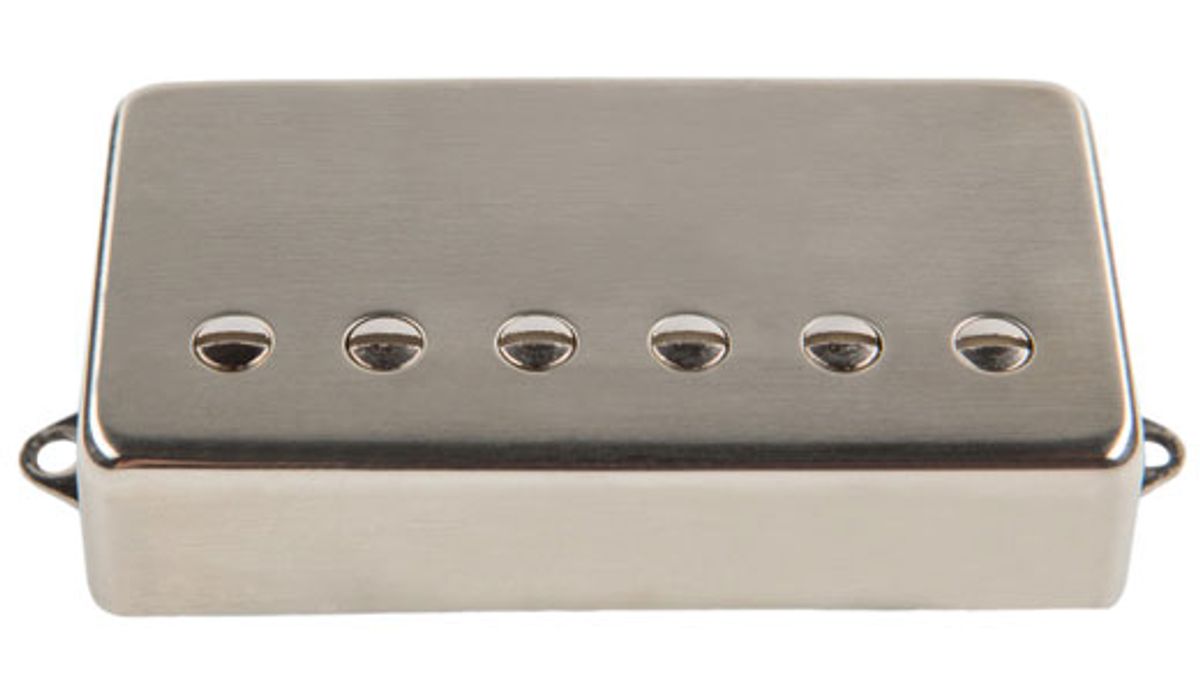
The NAMM 2015-released signature Thornbucker pickup from John Suhr.
Why are these pickups so popular? And why does their sound vary so much from unit to unit?
For as long as I can remember, I've tinkered with the pickups in my guitars, be it a simple adjustments or swapping them out for aftermarket models. While working with John Suhr on some new custom pickups, I found myself drawing from many years of experience as we narrowed down my ideal specs. This month I'll share my thoughts on winds, magnets, covers, and other factors that make a great-sounding pickup, with a focus on vintage PAF-style humbuckers.
Single-Coils Vs. Humbuckers
Back in the early '50s electric guitarists had only single-coil pickups. Early Tele, Strat, and P-90 pickups provided stinging, clear, robust tones that are still sought after and revered. I'm a big fan of single-coils and the tones they deliver, but like most guitarists, I don't like the 60-cycle hum that single-coils produce.
In 1955, Seth Lover developed the first commercially available humbucking pickups for Gibson, intended as replacements for noisy P-90 single-coils. These early PAF pickups made their first appearance on Gibson guitars in 1957 and have since achieved near-mythic status among aficionados of great electric guitar tone.
PAFs sounded warmer and fatter than their single-coil predecessors, but still retained much of the sweetness and clear treble response of the P-90. They were similar to P-90s in output, with DC resistances in the 7k to 8.5k range, considered fairly modest by modern standards.
Magnets, Winds, and Wire
There are many elements that affect a pickup's tone, and those elements varied quite a bit between early PAFs. When the two coils of a humbucker aren't wound exactly the same, some interesting (and cool) things happen. The pickup won't be 100% humbucking, but the high end opens up, and it can take on some of the qualities of a single-coil. The tone can seem more “3D," with a chiming top and less congestion in the mids.
Magnets and other materials also varied, because Gibson would use what they could get from their suppliers. PAFs utilized alnico magnets (made from a blend of aluminum, nickel, and cobalt) that were graded from alnico 2 to alnico 5. Early PAFs used all of these, though Gibson ultimately adopted alnico 5 as the standard by the early 1960s. After lots of pickup swapping, I've learned which magnets deliver what I consider optimum tone.
Most aftermarket pickups are equipped with either alnico 5 or alnico 2 magnets. Alnico 2 magnets have a warm tone with creamy mids and less output, while alnico 5 magnets provide higher output, more bass, and stinging, clear treble. To my ear, the less-common alnico 4 magnets have a balanced and clear tone with all frequencies present and even, and I love the way they sound in a bridge humbucker. If you compare two otherwise identical pickups with alnico 4 and alnico 5 magnets, the former will have slightly less output and edginess. You get clarity and balance without shrillness when playing single notes on treble strings high up the neck.
For neck humbuckers, I really like alnico 5 magnets. Neck pickups can sound dark, and alnico 5's extra treble helps keep the tone clear. Combine this magnet with slightly mismatched coils (with the screw coil closest to the neck wound a bit hotter), and you have a great-sounding neck pickup that provides warmth, clarity, and complexity.
Of course, one guitarist's “muddy" can be another's “warm." But generally speaking, I think a great set of pickups should exhibit evenness, sweetness, and clear highs without being shrill, and it should have enough output to give your guitar some bark and oomph without overwhelming your amp's input.
Not Hot
I'm not a big fan of high-output pickups. The core tone changes once a pickup is wound overly hot, and usually for the worse. Top-end clarity suffers and midrange increases, so lots of luck playing truly clean with a hot pickup!
Since modern amps have so much gain on tap and there are so many boost and overdrive pedals on the market, I feel it's unnecessary to rely on overly hot pickups for overdrive. A good low- to medium-output humbucker delivers great tone, versatility, and more than enough output for just about any style. Having said that, DC resistance doesn't tell the full story when it comes to a pickup's perceived output. A pickup using a weaker alnico 2 magnet needs to be wound hotter (that is, with more windings) to achieve the same output as an alnico 5 pickup.
To Cover, or Not to Cover?
Pickup covers affect the tone slightly, and some players prefer the tone and response of uncovered humbuckers. I've read that the effect of some covers can be compared to changing a guitar's volume pot from 500k to 300k. From my own experience, that's a fair comparison. Uncovered, a pickup may seem to have a bit more treble and openness. I've found that raw, pure-nickel covers have the least impact on tone, so I prefer that type.
Remember, pickups are relatively easy to switch out. So if you aren't happy with the tone of your guitar, maybe it's time for a swap! Until next month, I wish you great tone.
